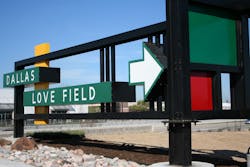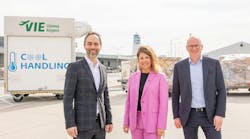In the olden days, airports operated under the maxim “if you build it, they will come.” Most felt there wasn’t a need to publicize and market their facilities and amenities.
But fast-forward to 2018, where travelers are spending record amounts of time — and money — in terminals across the country. And in most of the major cities, there are also airports competing for passengers. So we’re seeing airports step up their game in putting the best face on their terminals and amenities.
Nerissa Sugars is manager, air service development, customer experience, and branding at Hollywood Burbank Airport in Southern California, where travelers have their choice of five airports. “Of course, we want them to choose Hollywood Burbank. To do that, we need to reach them with a strategic marketing plan,” she said.
The most significant marketing development is the name change in 2016, from Bob Hope Airport to Hollywood Burbank Airport, said Sugars. “In 2014, the airport contracted an external agency, Anyone Collective in South Pasadena, to help us rebrand. The primary goal was to help attract new passengers, especially those east of the Rockies who are unaware Burbank is a viable option for traveling to and from Southern California,” she said.
The heart of the rebrand is the new name that also serves as a geographic identifier, said Sugars. “Research showed most people outside of California didn’t know where “Bob Hope Airport” is, so the need for a geographic identifier was critical,” she noted. “When the name first changed, we focused the bulk of our marketing efforts on general awareness – telling people who we are, where we are, and why Hollywood Burbank Airport is the best, most convenient way to fly in and out of the Los Angeles area.
So far, marketing the name change and new brand seems to be working, said Sugars. “Besides, of course, getting buy-in from the community and potential travelers, we really want to make sure the airlines are on board with the changes,” she said. “We’ve spoken to representatives from the carriers that service us and we’re consistently hearing they like the change because it helps clarify where we are.”
The next phase of the airport’s marketing strategy concentrates on calls-to-action and engagements with new potential customers, said Sugars. “We’re creating custom-targeted messaging across a larger base of target demographics,” she said.
Hollywood Burbank Airport works very closely with its marketing agency to determine what to highlight, said Sugars. “Again, we’re touting convenience. So whatever we promote has to be in line with that. The product or service has to help make the airport experience safe, pleasant, and comfortable for our busy travelers,” she said.
Social media plays a very important role as part of Hollywood Burbank Airport’s marketing efforts, said Sugars. “We do have a budget for media buys on all the major social media outlets, along with print publications,” she said. “But of course, our in-house social media specialist is able to promote airport amenities services, and certain destinations where the main cost is her staff time. Having social media as a marketing tool that’s generally free, and having someone dedicated to the upkeep of that social media presence is valuable.”
All this is done with three staffers whose workload includes marketing responsibilities, said Sugars. “We also have generous access to the staff at Anyone Collective, our external marketing agency.”
With bigger airports come bigger challenges — and opportunities. Tina Williams is the manager, business development, partnerships & advertising for Toronto Pearson International Airport, which served nearly 50 million passengers in 2017.
“Marketing our terminals is what assists in giving our passengers an experience beyond travel,” said Williams. “We approach every decision with a passenger-first mindset and being able to add excitement and new experiences to a passenger’s journey is made possible through marketing the unique qualities of Toronto Pearson.”
“It’s by offering unique brands and experiences that we show passengers that Toronto Pearson has an offering for all travelers,” said Williams.
The airport is constantly looking to push the envelope and bring better offerings to its passengers, said Williams. “Dylan’s Candy Bar recently opened a 1,100 square-foot location with more than 500 different items, including a wide variety of candies, a chocolate station and other candy-themed gifts,” she noted. “TripAdvisor chose Toronto Pearson to be the home for its first-ever retail location. It offers travel essentials and a large interactive display for passengers to learn more about Toronto and the surrounding area.”
Because Toronto Pearson’s approach marketing from a passenger-first standpoint, it looks at the journey of a traveller from their front door to the boarding gate of their flight, said Williams. “We highlight the services or products that add the most value and convenience to that passenger’s experience, with the goal of making Toronto Pearson a refreshing part of their journey,” she said.
Decisions about marketing at Toronto Pearson are made by looking at the most important touchpoints for a passenger at the airport, said Williams. “We analyze seasonal factors, like holidays or special days of observance, as well as the type of travellers we expect during a set time-frame, then develop an offering that is appropriate,” she explained.
There are recurring qualities that underline what makes a successful program, said Williams. “Anytime we can collaborate with partners, our message is stronger and more successful,” she said.
Toronto Pearson has many staff who contribute to marketing initiatives at the airport, said Williams. It also works with various agencies and in-house marketers from partner organizations. “We collaborate and share the workload to produce the best possible offerings.
“Also, combining our interests with a partner organization like American Express means that passengers who are a client of that partner can receive benefits for their brand loyalty, which tracks directly back to a focus on how we improve the passenger experience,” said Williams.
Social media is very important, both for direct and indirect appeals to our passengers and other stakeholders as part of the airport’s marketing efforts, said Williams. “Social media gives travellers the ability to reach out to Toronto Pearson directly, allowing our brand’s personality to be strengthened through positive interactions,” she said. “Sponsored social media advertising is also very successful for connecting passengers to the special offers or marketing initiatives that have the most relevance to them.”
But how do you market an airport and its amenities where is an agreement in place that doesn’t allow you to do it? Chris Perry, the communications manager at Dallas Love Field, relies on his communications efforts and the airport’s customers to do it for them.
“Due to the parameters of the Five Party Agreement to resolve the Wright Amendment, Dallas Love Field does not engage in any type of commercial marketing,” said Perry. “We engage in social media, media pitching and relying on our customers to tell our story.”
Despite the prohibition on marketing, it’s still important for Dallas Love Field to highlight what it offers, said Perry. “We want to showcase how our terminals represent what Dallas Love Field hopes to accomplish in customer satisfaction, convenience and accessibility, as well as generate revenue for the airport and city through our concessions,” he said.
In 2014, the airport opened a new terminal to coincide with nonstop flights from Dallas to destinations throughout the United States, said Perry. “In late 2018, we will open a new parking garage to expand parking capacity, as well as better manage our parking inventory,” he said.
Dallas Love Field likes to focus on different things, said Perry. “[We look at] awards won, as well as innovative endeavors the airport is taking on, such as a new bird-strike prevention technology and our baggage handling system,” he said.
The airport focuses on amenities and the customer experience, said Perry. If new initiatives or amenities are going to improve the customer experience, we are going to highlight those initiatives,” he said. “If it something another airport has not yet had, we are going to highlight that initiative.”
An example of that was a social media campaign to show how Dallas Love Field goes the extra mile for its customers. Four-year-old Luke Swofford lost his favorite toy, “Teddy Bear,” at Dallas Love Field as he and his family caught a flight to Denver in July 2017.
The airport went on alert to find the bear and the hunt for it went viral. Swofford was reunited with Teddy Bear a week later, thanks to the airport’s employees.
Perry manages social media and media relations by himself, but he does have a social media assistant and gets help from the city’s public information officers.
In the end, any airport can talk about its restaurants, free wi-fi, or pet therapy program, which are amenities found at many airports these days, said Hollywood Burbank Airport’s Sugars. “The thing we feel distinguishes us from other airports is our convenience. Our passengers are always telling us they love how easy is to get in and out of here,” she noted. “From our location near the interstate, to parking, to the security lines, to getting to your gate – the traveling experience here is one of the smoothest you’ll find anywhere. In fact, our official tagline for all marketing material is `Convenience Elevated.’”
Support from the top is key for marketing an airport, said Sugars. “Make sure you have full support from executive management that understands the value of the marketing initiative,” she said. Emphasize that any positive return on a successful marketing strategy takes time, she added.
Effective marketing also takes money, said Sugars. “Support from executive management ideally includes a workable budget to create ads or collateral, then place those items where they need to be,” she said.
Contract with an outside agency if possible, Williams advised. “We’re fortunate Anyone Collective is a full-service shop that does it all, including creative development and social and digital media data collection and analysis,” she said. “Most importantly our agency understands the parameters we face as an organization governed by an airport authority.”
For Toronto Pearson’s Williams, it’s all about the passengers. “Never be afraid to change course and forget all the things you’ve done in the past [but] focus on the passenger experience first,” she said. “Be ready to try new ideas and fail forward if the execution is not perfectly successful. Use all the key learnings you can gather to break with tradition and push towards an interesting and engaging new passenger experience.”
Dallas Love Field’s Perry advises not to forget about the effectiveness of social media. “Don’t be afraid of embracing social media. It is an easy way to reach thousands of customers and to build up goodwill with an audience,” he said. “It is very important for Love Field, because it gives us an avenue to interact directly with our customers and the working press, as well as get continuous feedback.”


